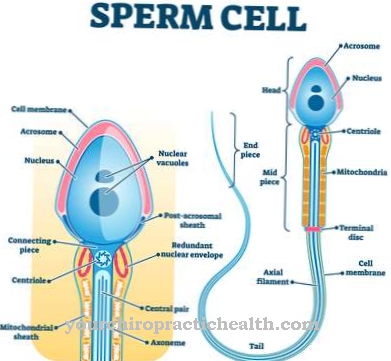A benign tumor is a tumor that does not meet the criteria for a malignant or semi-malignant tumor. In contrast to malignant tumors, benign tumors do not metastasize.
What is a benign tumor?

© nathan - stock.adobe.com
The increase in tissue is called a tumor. The term neoplasia is used synonymously. Neoplasms are new formations of body tissues that result from impaired regulation of cell growth. All tissues in the body can be affected. A distinction can be made between benign (benign) and malignant (malignant) variants. Malignant tumors are known colloquially as cancer.
Benign tumors are characterized by the fact that they displace the surrounding tissue, but do not infiltrate it. In addition, they do not form “settlements”. “Dislocations” is another word for metastases. In contrast, malignant tumors grow invasively. They grow into the surrounding tissue and thereby destroy it. They also spread via the blood or lymphatic system. The semi-malignant tumors exist as an intermediate form. As a rule, they do not metastasize, but grow in a destructive and infiltrating manner.
Benign tumors are well delimited from healthy tissue by capsules or pseudocapsules. The tissue of the tumors is homogeneous and well differentiated. The cells show little or no cell changes. Mitotic activity is low. This means that the benign tumors have a low rate of cell division.
Benign tumors are further differentiated according to their origin. A benign tumor is always named after the Latin name of its tissue of origin. The ending "-om" is appended to this name. For example, the benign tumor of the epithelial glandular tissue is called adenoma. A benign tumor that originates from adipose tissue is called a lipoma.
causes
The causes and development of benign tumors are not yet fully understood. Genetic disposition seems to play a role. In addition, the development of some benign tumors is promoted by taking certain drugs. For example, women who have taken oral contraceptives for many years have a higher risk of developing liver cell adenoma.
Other tumors occur in almost all people over a certain age. For example, benign prostatic hyperplasia is a widespread disease. The majority of men over the age of 50 have a benign enlarged prostate. Adenomas of the tonsils are also common. However, children are mostly affected here.
Symptoms, ailments & signs
The symptoms depend on the location and size of the tumor. Adenomas of the gastrointestinal tract bulge into the intestinal lumen, which can impede stool passage. The result is constipation and pain during bowel movements. Blood in the stool can also occur.
Adenomas of the tonsils, also known as polyps, can cause breathing difficulties and an increased susceptibility to infections. Adenomas of the thyroid gland can produce thyroid hormones independently of the hormone control circuit. The result is an overactive thyroid gland (hyperthyroidism) with symptoms such as diarrhea, racing heart, sweating or weight loss. Adrenal adenomas can also produce hormones.
If the hormone cortisol is overproduced, Cushing's disease can develop. Typical symptoms of this hypercortisolism are weight gain, fatigue, a bull's neck and parchment skin. Adenomas of the prostate often lead to difficulty urinating. Depending on the size of the tumor, bowel movements may also be impaired.
Adenomas of the ovaries only cause symptoms when they displace other organs due to their growth. Typical symptoms are bloating, problems with bowel movements and urination, abdominal pain and lower back pain. If the ovarian adenoma produces hormones, bleeding can occur regardless of your cycle. Liver cell adenomas are often associated with severe abdominal pain.
In addition, necrosis with life-threatening bleeding can occur. Adenomas of the pituitary gland lead to an increased release of hormones. Depending on the type of hormone, different symptoms can arise.
diagnosis
Various test methods are available for diagnosing benign tumors. With the help of the X-ray examination, pathological changes in organs or body parts can be made visible. In addition, imaging processes such as ultrasound, computed tomography or magnetic resonance tomography are used. Some adenomas are removed and then examined under a microscope to rule out malignant cancer.
Complications
A benign tumor can also cause a number of complications. First of all, there is a risk that the growth compresses the surrounding tissue and thereby damages hollow organs. If a blood vessel is compressed, it can lead to an insufficient supply of oxygen to limbs or organs. In the worst case, the tissue dies.
A benign tumor in the gastrointestinal tract can cause blockages or an obstruction in the intestines. If the bile is affected, the urine may no longer be able to drain properly and bile backlog occurs. Such a backlog can lead to jaundice, among other things, but also to infections and a urinary stasis kidney.
A benign tumor can also cause circulatory disorders. This can cause blood clots to form, which can trigger many other local complications. A tumor in the intestinal wall may break through the intestinal wall, which usually results in a life-threatening inflammation of the peritoneum.
As a result of a breakthrough, further fistulas can form in other organs such as the urinary bladder or the uterus, which in turn can become inflamed. When removing a benign tumor, there is a risk of tissue and nerve damage. Physically exhausting therapy methods such as chemotherapy can cause further symptoms.
When should you go to the doctor?
A doctor should always be consulted with a benign tumor. This can prevent the tumor from degenerating. As a rule, the doctor should be consulted if there is weight loss and discomfort in the stomach and intestines for no particular reason.
In particular, a bloody stool can indicate this tumor. Most patients experience painful bowel movements or severe constipation. Furthermore, a visit to the doctor is necessary if the patient frequently suffers from rapid heartbeat or profuse sweating.
An overactive thyroid very often indicates a benign tumor. In addition to the discomfort with bowel movements, pain when urinating should always be examined by a doctor. A feeling of fullness or severe flatulence can also indicate this disease.
Since the symptoms are not always specific, regular and early examinations can have a very positive effect on the course of the disease. First and foremost, if a benign tumor is suspected, a general practitioner can be seen. This usually refers the person affected to an internist or urologist.
Doctors & therapists in your area
Treatment & Therapy
The therapy depends on the type, location and size of the tumor. While small tumors in the intestinal area rarely cause symptoms, a small benign tumor in the brain can cause severe symptoms. Adenomas in the intestine tend to transform into malignant tumors, so the adenomas are usually removed during a colonoscopy.
Adenomas of the tonsils are also removed by means of an adenotomy if there are symptoms already in childhood. In the case of adenomas of the thyroid gland, the affected part of the thyroid gland is destroyed using radioiodine therapy or removed in a surgical procedure. Hormone-producing adrenal adenomas are also surgically removed.
Prostate adenomas are usually treated with drugs. In addition, phytopharmaceuticals and biogenic drugs are used. Invasive or surgical treatment is indicated for severe symptoms. Surgery is also performed for adenomas of the ovaries. In women over the age of 40, the entire fallopian tube is removed.
After the menopause, the uterus, ovaries and both fallopian tubes are also removed. Surgical removal is also recommended for large adenomas of the liver. Growth hormone-producing tumors of the pituitary gland, on the other hand, can be reduced in size with medication. However, depending on the size of the tumor, surgery may also be necessary.
Outlook & forecast
The prognosis for a benign tumor depends on the location and size of the tissue change. Life expectancy is normally not reduced. Despite the irregularity, some patients can enjoy a symptom-free lifestyle until the end of their lives. Nevertheless, there is a risk that the tumor will press against the surrounding organs, joints, glands, vessels or nerves. Their functionality is impaired and complaints arise. As the tumor continues to grow, the patient's health gradually deteriorates.
In severe cases, individual systems may malfunction or fail completely. Daily life is restricted and the patient needs help. Without medical care, internal injuries, pain, or life-threatening conditions can develop. Because of their tightness, benign tumors inside the skull often lead to restrictions in brain activity. The sensory functions are interrupted and the information recorded can no longer be processed sufficiently.
Although benign tumors can normally be easily removed, if the tumor is in an unfavorable location, there is a risk that removal will lead to complications and damage to the environment. In severe cases, benign tumors can mutate as they develop. Once they become malignant, the patient's prognosis worsens significantly.
prevention
Since the cause of most benign tumors has not yet been clarified, prevention is not possible.
Aftercare
The type and duration of aftercare depends on the location and treatment of the benign tumor. Often no aftercare measures are necessary. If the benign tumor was surgically removed, the healing of the surgical scars should be observed. If there are postoperative complications, intensive follow-up care is necessary.
As a rule, after the tumor has been successfully removed, several check-ups are carried out to determine whether the tumor will recur. In some parts of the body, such as the chest area, those affected can determine this themselves by regular palpation. However, regular examinations by a doctor are also recommended in these cases.
The exact interval between the checks is determined by the respective specialist. Some forms of benign tumors strongly stimulate the growth of the tissue after their removal, which can also lead to the formation of new ulcers. There is therefore in some cases an increased risk of malignant tumors.
As soon as those affected perceive changes again, they should therefore consult a specialist, regardless of the agreed control intervals. In some cases, due to their location and growth, benign tumors can be inoperable and, in the long term, fatal. Those affected should be closely monitored in these cases.
You can do that yourself
If a benign tumor is found, medical treatment is not always required. Which steps have to be taken in detail and what those affected can do themselves depends on the type, location and size of the tumor.
Adenomas of the tonsils, prostate, intestine, or brain are usually surgically removed. Patients have to be prepared for a few weeks of bed rest and possibly also change their diet. Ultimately, the doctor will tell the patient what steps he can take himself. In the case of larger intestinal tumors, for example, preparations for temporary incontinence can be useful.
With benign brain tumors, severe complications can arise due to the complexity of the procedure. It is therefore advisable to seek therapeutic support at an early stage. Preparing for the hospital stay also includes organizing all the necessary documents, medication and aids. Friends and relatives should also be informed.
If the procedure is successful, the patient can usually leave the hospital after a few days. After that, regular checkups are indicated. Sometimes it makes sense to change your lifestyle in order to reduce the risk of tumor recurrence.

.jpg)


.jpg)






















